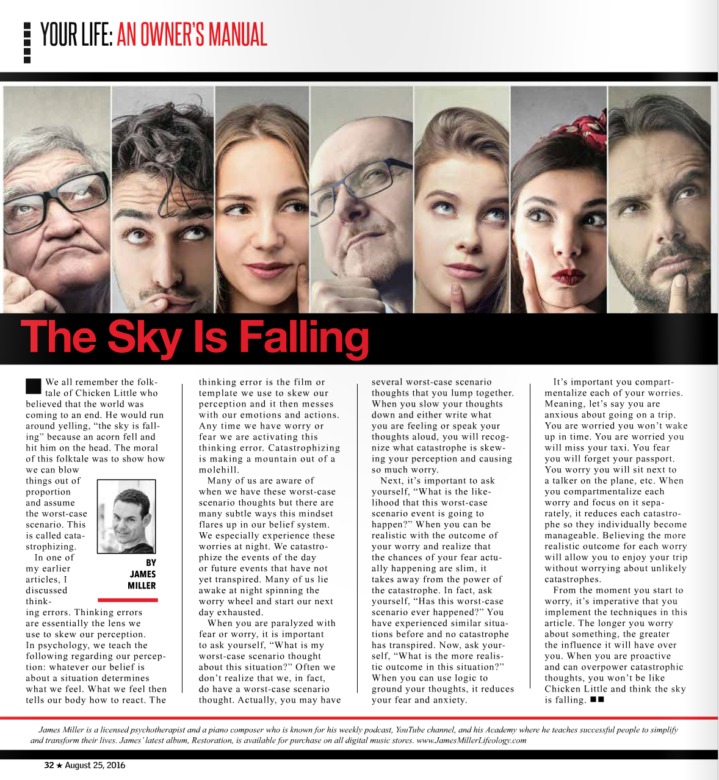We all remember the folktale of Chicken Little, who believed that the world was coming to an end. He would run around yelling, “the sky is falling” because an acorn fell and hit him on the head. The moral of this folktale was to show how we can blow things out of proportion and assume the worst-case scenario. This is called catastrophizing.
In one of my earlier articles, I discussed thinking errors. Thinking errors are the lens we use to skew our perception. In psychology, we teach the following regarding our perception: whatever our belief is about a situation determines what we feel. What we feel then tells our body how to react. The thinking error is the film or template we use to skew our perception, and it then messes with our emotions and actions. Any time we have worry or fear, we are activating this thinking error. Catastrophizing is making a mountain out of a molehill.
Many of us are aware of when we have these worst-case scenario thoughts, but there are many subtle ways this mindset flares up in our belief system. We especially experience these worries at night. We catastrophize the events of the day or future events that have not yet transpired. Many of us lie awake at night, spinning the worry wheel and start our next day exhausted.
When you are paralyzed with fear or worry, it is important to ask yourself, “What is my worst-case scenario thought about this situation?” Often we don’t realize that we, in fact, do have a worst-case scenario thought. Actually, you may have several worst-case scenario thoughts that you lump together. When you slow your thoughts down and either write what you are feeling or speak your thoughts aloud, you will recognize what catastrophe is skewing your perception and causing so much worry.
Next, it’s important to ask yourself, “What is the likelihood that this worst-case scenario event is going to happen?” When you can be realistic with the outcome of your worry and realize that the chances of your fear actually happening are slim, it takes away from the power of the catastrophe. In fact, ask yourself, “Has this worst-case scenario ever happened?” You have experienced similar situations before, and no catastrophe has transpired. Now, ask yourself, “What is the more realistic outcome in this situation?” When you can use logic to ground your thoughts, it reduces your fear and anxiety.
It’s crucial you compartmentalize each of your worries. Meaning, let’s say you are anxious about going on a trip. You are worried you won’t wake up in time. You are afraid you will miss your taxi. You fear you will forget your passport. You worry, you will sit next to a talker on the plane, etc. When you compartmentalize each worry and focus on it separately, it reduces each catastrophe, so they individually become manageable. Believing the more realistic outcome for each concern will allow you to enjoy your trip without worrying about unlikely catastrophes.
From the moment you start to worry, it’s imperative that you implement the techniques in this article. The longer you worry about something, the greater the influence it will have over you. When you are proactive and can overpower catastrophic thoughts, you won’t be like Chicken Little and think the sky is falling.
James Miller is a licensed psychotherapist and the executive producer and host of the nationally broadcasted and syndicated radio show James Miller | LIFEOLOGY®. For more information, please visit www.JamesMillerLIFEOLOGY.com or LIFEOLOGY.tv


 We all get overwhelmed and sometimes don’t know what to do. LIFE LESSONS is your new “go-to” book to help you navigate life.
We all get overwhelmed and sometimes don’t know what to do. LIFE LESSONS is your new “go-to” book to help you navigate life.